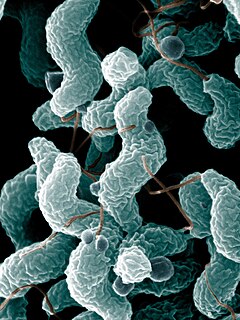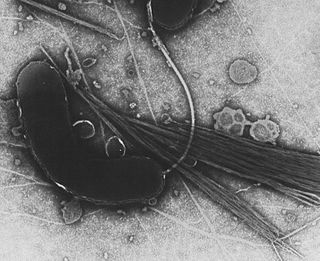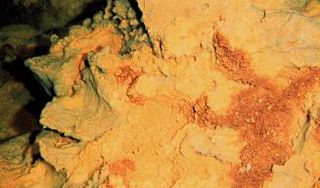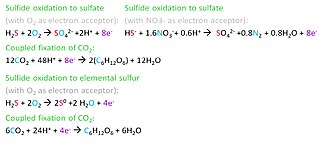Related Research Articles

Riftia pachyptila, commonly known as the giant tube worm, is a marine invertebrate in the phylum Annelida related to tube worms commonly found in the intertidal and pelagic zones. R. pachyptila lives on the floor of the Pacific Ocean near hydrothermal vents, and can tolerate extremely high hydrogen sulfide levels. These worms can reach a length of 3 m, and their tubular bodies have a diameter of 4 cm (1.6 in). Ambient temperature in their natural environment ranges from 2 to 30°C.
Chemotrophs are organisms that obtain energy by the oxidation of electron donors in their environments. These molecules can be organic (chemoorganotrophs) or inorganic (chemolithotrophs). The chemotroph designation is in contrast to phototrophs, which use solar energy. Chemotrophs can be either autotrophic or heterotrophic. Chemotrophs can be found on ocean floors where sunlight cannot reach. Or above ground, such as the case with iron bacteria.
Sulfur-reducing bacteria are microorganisms able to reduce elemental sulfur (S0) to hydrogen sulfide (H2S). These microbes use inorganic sulfur compounds as electron acceptors to sustain several activities such as respiration, conserving energy and growth, in absence of oxygen. The final product or these processes, sulfide, has a considerable influence on the chemistry of the environment and, in addition, is used as electron donor for a large variety of microbial metabolisms. Several types of bacteria and many non-methanogenic archaea can reduce sulfur. Microbial sulfur reduction was already shown in early studies, which highlighted the first proof of S0 reduction in a vibrioid bacterium from mud, with sulfur as electron acceptor and H2 as electron donor. The first pure cultured species of sulfur-reducing bacteria, Desulfuromonas acetoxidans, was discovered in 1976 and described by Pfennig Norbert and Biebel Hanno as an anaerobic sulfur-reducing and acetate-oxidizing bacterium, not able to reduce sulfate. Only few taxa are true sulfur-reducing bacteria, using sulfur reduction as the only or main catabolic reaction. Normally, they couple this reaction with the oxidation of acetate, succinate or other organic compounds. In general, sulfate-reducing bacteria, are able to use both sulfate and elemental sulfur as electron acceptors. Thanks to its abundancy and thermodynamic stability, sulfate is the most studied electron acceptor for anaerobic respiration that involves sulfur compounds. Elemental sulfur, however, is very abundant and important, especially in deep-sea hydrothermal vents, hot springs and other extreme environments, making its isolation more difficult. Some bacteria – such as Proteus, Campylobacter, Pseudomonas and Salmonella – have the ability to reduce sulfur, but can also use oxygen and other terminal electron acceptors.

Beggiatoa is a genus of Gammaproteobacteria belonging the order Thiotrichales, in the Proteobacteria phylum. This genus was one of the first bacteria discovered by Russian botanist Sergei Winogradsky. During his research in Anton de Bary’s laboratory of botany in 1887, he found that Beggiatoa oxidized hydrogen sulfide (H2S) as energy source, forming intracellular sulfur droplets, oxygen is the terminal electron acceptor and CO2 is used as carbon source. Winogradsky named it in honor of the Italian doctor and botanist Francesco Secondo Beggiato. Winogradsky referred to this form of metabolism as "inorgoxidation" (oxidation of inorganic compounds), today called chemolithotrophy. These organisms live in sulfur-rich environments such as soil, both marine and freshwater, in the deep sea hydrothermal vents and in polluted marine environments. The finding represented the first discovery of lithotrophy. Two species of Beggiatoa have been formally described: the type species Beggiatoa alba and Beggiatoa leptomitoformis, the latter of which was only published in 2017. This colorless and filamentous bacterium, sometimes in association with other sulfur bacteria (for example the genus Thiothrix), can be arranged in biofilm visible at naked eye formed by very long white filamentous mate, the white color is due to the stored sulfur. Species of Beggiatoa have cells up to 200 µ in diameter and they are one of the largest prokaryotes on Earth.
Methanosarcina acetivorans is a versatile methane producing microbe which is found in such diverse environments as oil wells, trash dumps, deep-sea hydrothermal vents, and oxygen-depleted sediments beneath kelp beds. Only M. acetivorans and microbes in the genus Methanosarcina use all three known metabolic pathways for methanogenesis. Methanosarcinides, including M. acetivorans, are also the only archaea capable of forming multicellular colonies, and even show cellular differentiation. The genome of M. acetivorans is one of the largest archaeal genomes ever sequenced. Furthermore, one strain of M. acetivorans, M. a. C2A, has been identified to possess an F-type ATPase along with an A-type ATPase.

Epsilonproteobacteria are a class of Proteobacteria. All species of this class are, like all Proteobacteria, Gram-negative.

The class Gammaproteobacteria belongs to the Proteobacteria phylum and contains about 250 genera, which makes it the most genera-rich taxon of the Prokaryotes. Several medically, ecologically, and scientifically important groups of bacteria belong to this class. It is composed by all Gram-negative microbes and is the most phylogenetically and physiologically diverse class of Proteobacteria.
Thermococcus litoralis is a species of Archaea that is found around deep-sea hydrothermal vents as well as shallow submarine thermal springs and oil wells. It is an anaerobic organotroph hyperthermophile that is between 0.5–3.0 μm (20–118 μin) in diameter. Like the other species in the order thermococcales, T. litoralis is an irregular hyperthermophile coccus that grows between 55–100 °C (131–212 °F). Unlike many other thermococci, T. litoralis is non-motile. Its cell wall consists only of a single S-layer that does not form hexagonal lattices. Additionally, while many thermococcales obligately use sulfur as an electron acceptor in metabolism, T. litoralis only needs sulfur to help stimulate growth, and can live without it. T. litoralis has recently been popularized by the scientific community for its ability to produce an alternative DNA polymerase to the commonly used Taq polymerase. The T. litoralis polymerase, dubbed the vent polymerase, has been shown to have a lower error rate than Taq but due to its proofreading 3’–5’ exonuclease abilities.
Hydrogenobacter thermophilus is an extremely thermophilic, straight rod (bacillus) bacterium. TK-6 is the type strain for this species. It is a Gram negative, non-motile, obligate chemolithoautotroph. It belongs to one of the earliest branching order of Bacteria. H. thermophilus TK-6 lives in soil that contains hot water. It was one of the first hydrogen oxidizing bacteria described leading to the discovery, and subsequent examination of many unique proteins involved in its metabolism. Its discovery contradicted the idea that no obligate hydrogen oxidizing bacteria existed, leading to a new understanding of this physiological group. Additionally, H. thermophilus contains a fatty acid composition that had not been observed before.
Arcobacter is a genus of Gram-negative, spiral-shaped bacteria in the class Epsilonproteobacteria. It shows an unusually wide range of habitats, and some species can be human and animal pathogens. Species of the genus Arcobacter are found in both animal and environmental sources, making it unique among the epsilonproteobacteria. This genus currently consists of five species: A. butzleri, A. cryaerophilus, A. skirrowii, A. nitrofigilis, and A. sulfidicus, although several other potential novel species have recently been described from varying environments. Three of these five known species are pathogenic. Members of this genus were first isolated in 1977 from aborted bovine fetuses. They are aerotolerant, Campylobacter-like organisms, previously classified as Campylobacter. The genus Arcobacter, in fact, was created as recently as 1992. Although they are similar to this other genus, Arcobacter species can grow at lower temperatures than Campylobacter, as well as in the air, which Campylobacter cannot.

The class Zetaproteobacteria is the sixth and most recently described class of the Proteobacteria. Zetaproteobacteria can also refer to the group of organisms assigned to this class. The Zetaproteobacteria were originally represented by a single described species, Mariprofundus ferrooxydans, which is an iron-oxidizing neutrophilic chemolithoautotroph originally isolated from Loihi Seamount in 1996 (post-eruption). Molecular cloning techniques focusing on the small subunit ribosomal RNA gene have also been used to identify a more diverse majority of the Zetaproteobacteria that have as yet been unculturable.

Mariprofundus ferrooxydans is a neutrophilic, chemolithotrophic, Gram-negative bacterium which can grow by oxidising ferrous to ferric iron. It is one of the few members of the class Zetaproteobacteria in the phylum Proteobacteria. It is typically found in iron-rich deep sea environments, particularly at hydrothermal vents. M. ferrooxydans characteristically produces stalks of solid iron oxyhydroxides that form into iron mats. Genes that have been proposed to catalyze Fe(II) oxidation in M. ferrooxydans are similar to those involved in known metal redox pathways, and thus it serves as a good candidate for a model iron oxidizing organism.
Nautilia profundicola is a Gram-negative chemolithoautotrophic epsilonproteobacterium found around hydrothermal vents in the deep ocean. It was first discovered in 1999 on the East Pacific Rise at depth of 2,500 metres (8,200 ft), on the surface of the polychaete worm Alvinella pompejana. Nautilia profundicola lives symbiotically on the dorsal hairs of A. pompejana but they may also form biofilms and live independently on the walls of hydrothermal vents. The ability of N. profundicola to survive in an anaerobic environment rich in sulfur, H2 and CO2 of varying temperature makes it a useful organism to study, as these are the conditions that are theorized to have prevailed around the time of the earliest life on earth.
Sulfurimonas is a bacterial genus within the class of Epsilonproteobacteria, known for reducing nitrate, oxidizing both sulfur and hydrogen, and containing Group IV hydrogenases. This genus consists of four species: Sulfurimonas autorophica, Sulfurimonas denitrificans, Sulfurimonas gotlandica, and Sulfurimonas paralvinellae. The genus' name is derived from "sulfur" in Latin and "monas" from Greek, together meaning a “sulfur-oxidizing rod”. The size of the bacteria varies between about 1.5-2.5 μm in length and 0.5-1.0 μm in width. Members of the genus Sulfurimonas are found in a variety of different environments which include deep sea-vents, marine sediments, and terrestrial habitats. Their ability to survive in extreme conditions is attributed to multiple copies of one enzyme. Phylogenetic analysis suggests that members of the genus Sulfurimonas have limited dispersal ability and its speciation was affected by geographical isolation rather than hydrothermal composition. Deep ocean currents affect the dispersal of Sulfurimonas spp., influencing its speciation. As shown in the MLSA report of deep-sea hydrothermal vents Epsilonproteobacteria, Sulfurimonas has a higher dispersal capability compared with deep sea hydrothermal vent thermophiles, indicating allopatric speciation.
Sulfurovum lithotrophicum is a species of bacteria, the type species of its genus. It is a sulfur-oxidizing chemolithoautotroph within the ε-Proteobacteria isolated from Okinawa Trough hydrothermal sediments. It is mesophilic and also oxidises thiosulfate. It is a Gram-negative, non-motile and coccoid to oval-shaped bacterium. The type strain is 42BKTT.
Sulfurimonas paralvinellae is a hydrogen- and sulfur-oxidizing ε-proteobacterium. It is a mesophilic chemolithoautotroph.
Marinitoga piezophila is a species of rod-shaped, thermo-piezophilic bacteria. It is, anaerobic, chemo-organotrophic, sulfur-reducing, motile, have a mean length of 1-1.5 micrometres and stains Gram-negative. The type strain is KA3T.

Microbial oxidation of sulfur is the oxidation of sulfur by microorganisms to produce energy. The oxidation of inorganic compounds is the strategy primarily used by chemolithotrophic microorganisms to obtain energy in order to build their structural components, survive, grow and reproduce. Some inorganic forms of reduced sulfur, mainly sulfide (H2S/HS−) and elemental sulfur (S0), can be oxidized by chemolithotrophic sulfur-oxidizing prokaryotes, usually coupled to the reduction of oxygen (O2) or nitrate (NO3−).

The hydrothermal vent microbial community includes all unicellular organisms that live and reproduce in a chemically distinct area around hydrothermal vents. These include organisms in the microbial mat, free floating cells, or bacteria in an endosymbiotic relationship with animals. Chemolithoautotrophic bacteria derive nutrients and energy from the geological activity at Hydrothermal vents to fix carbon into organic forms. Viruses are also a part of the hydrothermal vent microbial community and their influence on the microbial ecology in these ecosystems is a burgeoning field of research.
Nitratiruptor sp. is a genus of deep sea gram-negative ε-proteobacteria isolated from Iheya North Hydrothermal field in Okinawa Trough (Japan). This rod-shaped microorganism grows chemolithoautotrophically in a wide variety of electron donors and acceptors in absence of light and oxygen. It is also a thermophilic group capable of growing within the range of 37–65 °C with the optimal at 55 °C.
References
- 1 2 3 Rich Boden; Kathleen M. scott; J. williams; S. Russel; K. antonenen; Alexander W. Rae; Lee P. Hutt (June 2017). "An evaluation of Thiomicrospira, Hydrogenovibrio and Thioalkalimicrobium: reclassification of four species of Thiomicrospira to each Thiomicrorhabdus gen. nov. and Hydrogenovibrio, and reclassification of all four species of Thioalkalimicrobium to Thiomicrospira". International Journal of Systematic and Evolutionary Microbiology . 67 (5): 1140–1151. doi: 10.1099/ijsem.0.001855 . PMID 28581925.
- ↑ Jannasch, H. W.; Wirsen, C. O.; Nelson, D. C.; Robertson, L. A. (1985). "Thiomicrospira crunogena sp. nov., a Colorless, Sulfur-Oxidizing Bacterium from a Deep-Sea Hydrothermal Vent". International Journal of Systematic Bacteriology. 35 (4): 422–424. doi: 10.1099/00207713-35-4-422 . ISSN 0020-7713.
- ↑ Kathleen M. Scott; Stefan M. Sievert; Fereniki N. Abril; Lois A. Ball; Chantell J. Barrett; Rodrigo A. Blake; Amanda J. Boller; Patrick S. G. Chain; Justine A. Clark; Carisa R. Davis; Chris Detter; Kimberly F. Do; Kimberly P. Dobrinski; Brandon I. Faza; Kelly A. Fitzpatrick; Sharyn K. Freyermuth; Tara L. Harmer; Loren J. Hauser; Michael Hugler; Cheryl A. Kerfeld; Martin G. Klotz; William W. Kong; Miriam Land; Alla Lapidus; Frank W. Larimer; Dana L. Longo; Susan Lucas; Stephanie A. Malfatti; Steven E. Massey; Darlene D. Martin; Zoe McCuddin; Folker Meyer; Jessica L. Moore; Luis H. Jr Ocampo; John H. Paul; Ian T. Paulsen; Douglas K. Reep; Qinghu Ren; Rachel L. Ross; Priscila Y. Sato; Phaedra Thomas; Lance E. Tinkham & Gary T. Zeruth (November 2006). "The genome of deep-sea vent chemolithoautotroph Thiomicrospira crunogena XCL-2". PLOS Biology . 4 (12): e383. doi:10.1371/journal.pbio.0040383. PMC 1635747 . PMID 17105352.